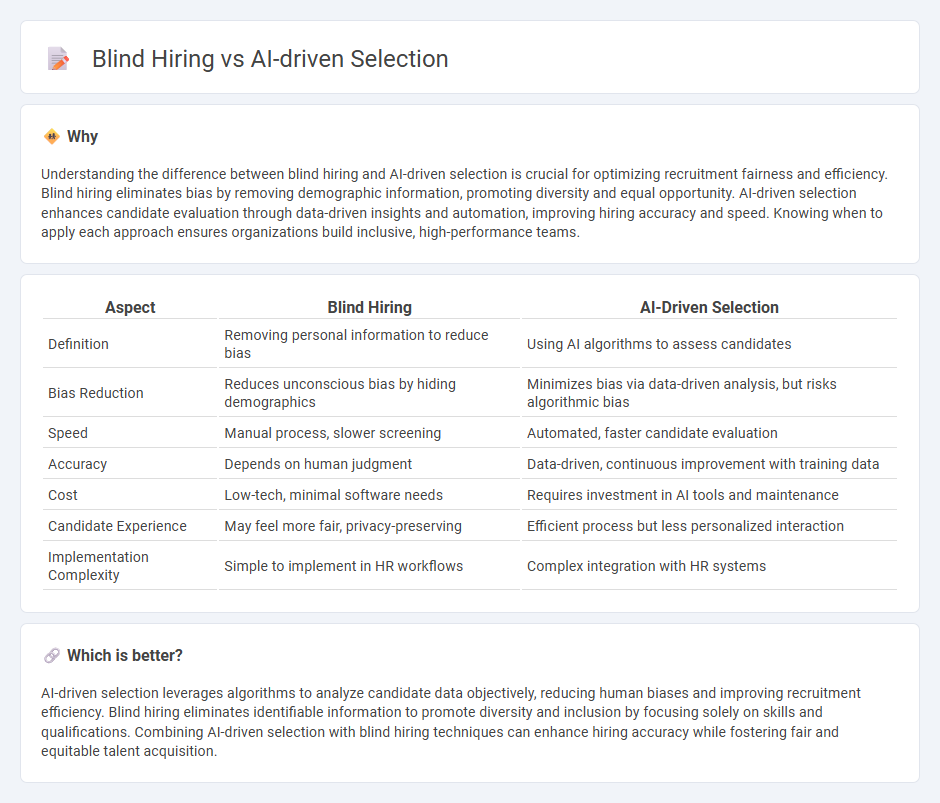
Blind hiring eliminates bias by removing personal information from resumes, focusing solely on skills and qualifications to enhance diversity and fairness in recruitment. AI-driven selection uses machine learning algorithms to analyze candidate data, improving efficiency and identifying the best fit based on patterns and predictive analytics. Explore how these innovative approaches transform talent acquisition strategies and drive inclusive workforce development.
Why it is important
Understanding the difference between blind hiring and AI-driven selection is crucial for optimizing recruitment fairness and efficiency. Blind hiring eliminates bias by removing demographic information, promoting diversity and equal opportunity. AI-driven selection enhances candidate evaluation through data-driven insights and automation, improving hiring accuracy and speed. Knowing when to apply each approach ensures organizations build inclusive, high-performance teams.
Comparison Table
| Aspect | Blind Hiring | AI-Driven Selection |
|---|---|---|
| Definition | Removing personal information to reduce bias | Using AI algorithms to assess candidates |
| Bias Reduction | Reduces unconscious bias by hiding demographics | Minimizes bias via data-driven analysis, but risks algorithmic bias |
| Speed | Manual process, slower screening | Automated, faster candidate evaluation |
| Accuracy | Depends on human judgment | Data-driven, continuous improvement with training data |
| Cost | Low-tech, minimal software needs | Requires investment in AI tools and maintenance |
| Candidate Experience | May feel more fair, privacy-preserving | Efficient process but less personalized interaction |
| Implementation Complexity | Simple to implement in HR workflows | Complex integration with HR systems |
Which is better?
AI-driven selection leverages algorithms to analyze candidate data objectively, reducing human biases and improving recruitment efficiency. Blind hiring eliminates identifiable information to promote diversity and inclusion by focusing solely on skills and qualifications. Combining AI-driven selection with blind hiring techniques can enhance hiring accuracy while fostering fair and equitable talent acquisition.
Connection
Blind hiring techniques reduce bias by anonymizing candidate information, allowing AI-driven selection algorithms to focus solely on skills and qualifications. AI-powered tools analyze large datasets from anonymized resumes and assessments to identify top talent efficiently and objectively. This connection enhances diversity and inclusion while improving the accuracy and fairness of recruitment decisions in human resources.
Key Terms
Algorithmic Bias
Algorithmic bias in AI-driven selection can inadvertently perpetuate discrimination by relying on historical data that reflects existing inequalities, resulting in unfair candidate evaluations. Blind hiring aims to reduce such bias by anonymizing resumes and focusing on skills and qualifications without demographic indicators, promoting greater diversity and fairness. Explore the nuances of these approaches to understand how organizations can implement equitable hiring practices.
Diversity Metrics
AI-driven selection enhances diversity metrics by reducing unconscious bias through data-driven candidate evaluations, ensuring fair representation across gender, ethnicity, and experience levels. Blind hiring methods eliminate identifiable candidate information to focus on skills but may overlook broader diversity dimensions such as cultural background or cognitive diversity. Explore how AI-driven solutions can optimize your diversity recruitment strategies with precise analytics and inclusive candidate profiling.
Fairness Auditing
AI-driven selection leverages algorithms to analyze candidate data, aiming to reduce human bias and improve fairness in hiring decisions. Fairness auditing in AI recruitment tools ensures these systems operate transparently and equitably, identifying and mitigating potential biases related to gender, race, or age. Explore how fairness auditing enhances AI-driven hiring practices to promote diversity and inclusion.
Source and External Links
Intelligent Selection from Oleeo - This AI-driven recruitment tool uses data science and machine learning to make prescriptive recommendations for interview and hire decisions, reducing bias and improving hiring quality.
Fitting AI Into Your HR Recruitment Processes - AI transforms the screening of resumes and candidate profiles by increasing speed and accuracy, minimizing human bias, and promoting diversity.
AI in Recruiting by IBM - AI-powered recruitment processes are designed to be efficient, cost-effective, scalable, and legally compliant, using techniques like resume screening and predictive analytics.
 dowidth.com
dowidth.com